Weekly Fishing Report: August 2
Welcome to August! As many of us know, in a blink it will be Labor Day weekend. Although we are more than halfway through the summer there is still time to plan large scale or small scale fishing outings with youngsters. If headed to the beach for vacation, consider bringing a hefty surf fishing outfit and let them enjoy some catch and release action in the evenings with inshore sharks and sting rays. Kids are always fascinated with sharks. If you are more local, consider white perch and channel catfish if you’re near a tidal river. For those more inland there are bluegill sunfish in just about every pond or lake that dot the Maryland landscape. The key to any youth fishing experience is to get them on fish to keep their interest up.
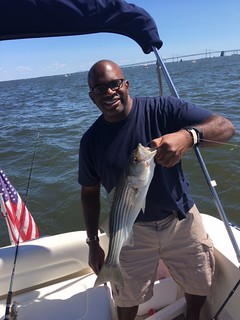
Curtis Hefflin holds a striped bass for the camera before releasing it near Podickory Point; Photo by Curtis Hefflin
There tends to be a lot of water moving through the Conowingo Dam gates due to heavy rains last week in the upper Susquehanna River watershed. The lower Susquehanna water levels are high and discolored. One would suspect it might be a little tough to be able to sling a heavy swimbait out into the dam pool till water levels calm down. When they do the early mornings have been the time to be there to get in on the striped bass action. Reports from the Susquehanna Flats area for early morning topwater fishing for striped bass have not been encouraging this week.
In the upper bay region the striped bass fishing continues to be very good at three traditional locations this week. First is Podickory Point where boats have been anchoring up on the channel edges there and chumming. The 30’ edge tends to be one of the more reliable depths and most are spotting fish on depth finders before starting a chum slick. Swan and the Love Point areas have also been reliable places to chum. In all three places sub-legal fish in the two or three year class are very active in the chum slicks and the larger striped bass are holding to the back of the chum slick holding close to the bottom. A few small bluefish are starting to show up this week high in the chum slicks and channel catfish have been holding the bottom.
Live lining spot is certainly a good option as the tasty little guys become more abundant on the inside of Hacketts Bar or the shallow ends of the Bay Bridge. Trolling is always an option for some and there are some nice striped bass being caught along the main channel edges near the chumming fleets. Red surge tube lures (hoses) and Storm type swimshads have been popular behind inline weights. Chunking up current of the Bay Bridge Piers can offer some action at times and jigging is always worth a stop at pier bases if you are in the vicinity of the bridge.
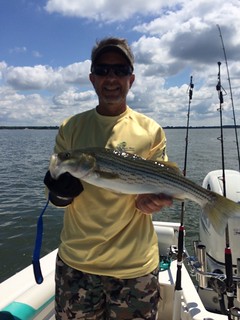
Herb Floyd holds up a striped bass that he caught while jigging in the lower Choptank River; Photo by Rhonda Floyd
Fishing for white perch in the tidal rivers and shoals out in the upper bay region can offer some fun bottom fishing. Bloodworms tend to be the preferred bait but peeler crab can also be a good option. Old piers, submerged rocks and similar structure in the tidal rivers can offer some ultra-light spinning action with small jigs and beetle-spin type lures, in the morning and evening hours. Water temperatures have dropped a bit recently due to cooler weather so white perch can be active in shallower waters. White perch populations are up as much as 118 percent overall, based on 2017 winter survey results so anglers may enjoy good fishing for years to come.
Surface water temperatures in the middle bay region have dropped to 78° recently and that will help with general activity of fish. A mix of sub-legal striped bass and bluefish have been making life miserable for small menhaden in the middle bay region usually near the mouths of some of the tidal rivers and shipping channel edges. They have been pushing bait up to the surface, which sets up a classic situation where jigging underneath can get one into larger striped bass. Herb Floyd holds up one that he caught while jigging in the lower Choptank River.
Trolling is a good option in the middle bay region if for no other reason you can cover a lot of water to find fish that may be scattered. Most are trolling with bucktails dressed with sassy shads or twistertails, red surge tube lures, Storm type swim shads or small spoons. All are being pulled behind inline weights or planers
There are good numbers of spot to be found on shoal areas in the tidal rivers and live lining is a great option along some of steeper channel edges in Eastern Bay, the Hill, Thomas Point and wherever fish can be found suspended along channel edges. Bluefish are part of the equation but they are perfect size for placing in smokers or on the grill. Good numbers of larger spot along with a mix of white perch and croakers are being found in areas such as the mouth of Eastern Bay, the mouth of the Choptank and Little Choptank. Peeler crab, bloodworms have been good baits to use on bottom rigs.
The lower bay region usually is the first stop for summer migrants coming up the bay and this week it is the Spanish mackerel making their first strong debut to the region. They can be caught on top with small spoons or jigs when they are mixing it up with bluefish and small striped bass chasing bait. The tried and true method when specifically targeting Spanish mackerel is to troll small Drone or similar type spoons behind inline weight or planers at a good clip.
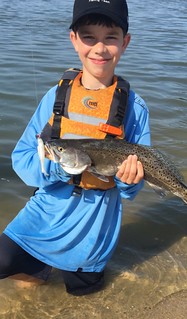
Nicklas Long is all smiles with this speckled trout he caught while fishing with his dad out of a kayak; Photo by Travis Long
Chumming near the Target Ship and the Middle Grounds continues to be popular for a mix of bluefish and cobia. Most of the cobia are undersized but it only takes one big one to make anyone’s day. Most are using cut bait in their chum slicks. Those specifically targeting cobia have been looking for them around the Target Ship and buoys and casting skirted bucktails, live spot or live eels. So far success has not been what it was this time last year. There is some chumming action for a mix of striped bass and bluefish in the lower Potomac near St. George’s Island.
Bottom fishing for large spot and croaker continues to be excellent in the lower Patuxent River near Hellen’s Bar and the Hawk’s Nest and in the lower Potomac. A falling tide tends to offer the best fishing opportunities and white perch and channel catfish can also be part of the mix. Bloodworms are the best bait for spot and peeler crab will work well for croaker and white perch. There are plenty of blue catfish around the Route 301 Bridge area all the way up to the Wilson Bridge and they can be caught on cut bait.
On the Tangier/Pocomoke Sound area bottom fishing for a mix of spot, croaker, kingfish has been good in some of the deeper areas of the sounds. Speckled trout and small bluefish can also be part of the mix. There are some flounder holding along channel edges for those who look for them. Cooler water temperatures may spur on the shallow water speckled trout fishery this week for those casting soft plastics or drifting peeler crab baits.
Before we move into the crabbing, freshwater and ocean sections, here is an update and bay fishing conditions forecast from the team with Click Before You Cast.
Weekly Fishing Conditions Forecast Summary
(Aug. 2-9, 2017)
Maryland’s mainbay surface and upper water column temperatures are in the low 80s with numerous rivers also showing warm conditions. The cool water from last weekend’s rains has reached the head of the bay resulting in a 5 degree drop in local water temperature. Unfortunately, the storm related sediment plume is also making its way through the upper bay. Elevated water levels are also reaching Little Falls on the Potomac River, so keep an eye out for poor water clarity in that and downstream areas. There continues to be lots of Maryland waters have adequate oxygen from surface to bottom so the focus on deeper waters that will provide best combination of cool water and adequate oxygen.
- While avoiding the sediment plume, anglers may want to explore the Chesapeake Bay bridge area up to Rock Hall at depths down to about 30 feet. This area has a good combination of cool water with adequate oxygen. Also consider Eastern Bay and main bay areas outside of the mouth of the Choptank River.
- The best fishing areas could be further refined by intersecting these prime areas with underwater points, drop-offs, large schools of baitfish and moving water.
- If present, avoid fishing in any large algal blooms. Currently algal blooms are beginning to show up in the lower Potomac, western shore and on the east side below the bay bridge.
- In addition to the poor water clarity in the upper bay resulting from the weekend storms, some areas of poor water clarity could occur as a result of localized rainfall possible from predicted rainfall/T-storms later this week and early next week.
- Take advantage of the upcoming full moon on Aug. 8, 2017 and the preceding days for above average tidal currents.
- After expected winds Thursday and Friday, bay conditions should be relatively stable for the upcoming week with a slight cooling trend after Friday.
For more detailed and up-to-date fishing conditions in your area of the bay, be sure to check out Eyes on the Bay’s Click Before You Cast. Since this is a new feature for Chesapeake Bay anglers, drop us a line with comments or suggestions.
Recreational crabbing continues to move along past the half way point of summer. Crabs are shedding and light crabs need to be culled out of one’s catch since they will generally not be welcomed at a crab feast. Recreational crabbing has been excellent in the lower bay region’s tidal rivers and creeks; both chicken necks and razor clams are working well. In the middle bay region, crabbing has been good with most crabbers being able to catch a bushel per outing. The upper bay tidal rivers have been offering up two to three dozen crabs per outing. The upper Elk River near the C&D Canal has been offering some of the better crabbing opportunities in the upper bay.
The western region of the state received a lot of rain late last week as did many other areas. The North Branch and the upper Potomac water levels have been up and waters discolored but they are starting to return to more normal conditions. Trout fishing in the catch and return management waters can offer some wonderful fishing for those who want to try their hand at fly fishing. The upper Potomac smallmouth bass tend to be active in the mornings and topwater lures are a fun way to entice them to strike near deep water current breaks and boulder fields. Tubes are another good choice when fished near current breaks or underwater ledges.
Deep Creek Lake will be busy with vacationers and there will be some limited action near floating docks for a mix of largemouth and smallmouth bass. This might be a good time to think about visiting some of the less popular lakes and reservoirs in the region. Information can be found on the Freshwater Fishing Hot Spots site.
Largemouth bass fishing is a mainstay during the summer months and the early morning hours are often the best time to enjoy the excitement that shallow topwater action can provide. Frogs, poppers, buzzbaits and chatterbaits are all good choices when fishing the shallows. As bass retreat to shade for the brighter daylight hours it will take a more subtle and slower presentation to get them to bite. Whacky rigged stick worms or similar plastics flipped under docks, overhanging brush, near sunken wood or through floating grass can entice them to pick up a bait.
This year has been a banner year for largemouth bass production at the Manning Hatchery in southern Maryland. Approximately 300,000 largemouth bass fingerlings were stocked into the tidal Potomac River this past summer.
For those who enjoy catch and release fishing for American and hickory shad or hope to, there is good news. Fisheries hatchery crews stocked 750,000 hickory shad larvae and 87,000 hickory shad juveniles into the Patapsco River recently. An additional 225,000 American shad larvae and 75,250 American shad juveniles were also stocked into the Patapsco River. The Choptank/ Tuckahoe Rivers were stocked with 2,530,000 American shad larvae and 403,000 American shad juveniles. There is hopefully a future for the Patapsco River fishery and the Choptank and Tuckahoe already have a good hickory shad fishery and there is the promise of an American shad fishery which the restoration crews have been working on for several years.
At Ocean City, the weekend weather knocked a lot of fishermen out of the ballgame due to strong winds and rain. Water temperatures are about 73° in the surf and fishing for kingfish has been good in the mornings and evenings. Small bluefish and a mix of flounder, blowfish and spot tend to round out the summer mix. For those with large cut baits and stout surf casting outfits there is some catch and release action with inshore sharks and sting rays.
At the inlet and Route 50 Bridge area sheepshead are being caught near the jetty rocks and bridge piers on sand fleas. Flounder can also be found in the area and at night when boat traffic calms down bluefish and a few striped bass are being caught by casting lures or drifting cut baits.
“No, I reckon there wasn’t much to do in the summertime, but it got to be September before you knew it, with the big saltwater fish beginning to run, and the high moon-swollen tides to make the marsh-hen shooting easy on the first big northern. And then the torture of school and shoes began…” -Robert Ruark, The Old Man and the Boy
 ABOUT THE AUTHOR Keith Lockwood has been writing the Fishing Report since 2003 and has had a long career as a fisheries research biologist since 1973. Over the course of his career he has studied estuarine fishery populations, ocean species, and over a decade long study of bioaccumulation of chemicals in aquatic species in New Jersey. Upon moving to Oxford on the eastern shore of Maryland; research endeavors focused on a variety of catch and release studies as well as other fisheries related research at the Cooperative Oxford Laboratory. Education and outreach to the fishing public has always been an important component to the mission of these studies. Keith is an avid outdoorsman enjoying hunting, fishing, bird dogs, family and life on the eastern shore of Maryland.
ABOUT THE AUTHOR Keith Lockwood has been writing the Fishing Report since 2003 and has had a long career as a fisheries research biologist since 1973. Over the course of his career he has studied estuarine fishery populations, ocean species, and over a decade long study of bioaccumulation of chemicals in aquatic species in New Jersey. Upon moving to Oxford on the eastern shore of Maryland; research endeavors focused on a variety of catch and release studies as well as other fisheries related research at the Cooperative Oxford Laboratory. Education and outreach to the fishing public has always been an important component to the mission of these studies. Keith is an avid outdoorsman enjoying hunting, fishing, bird dogs, family and life on the eastern shore of Maryland.
Want the Weekly Fishing Report sent right to your inbox? Click here to sign up!

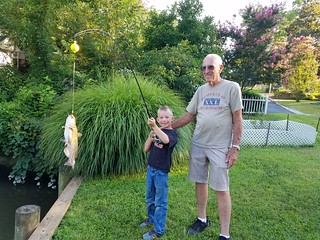
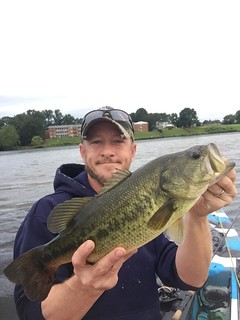
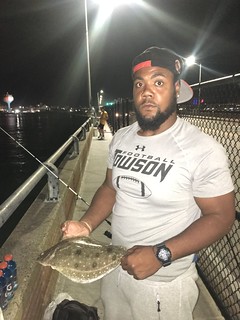
 1-888-373-7888
1-888-373-7888 233733
233733